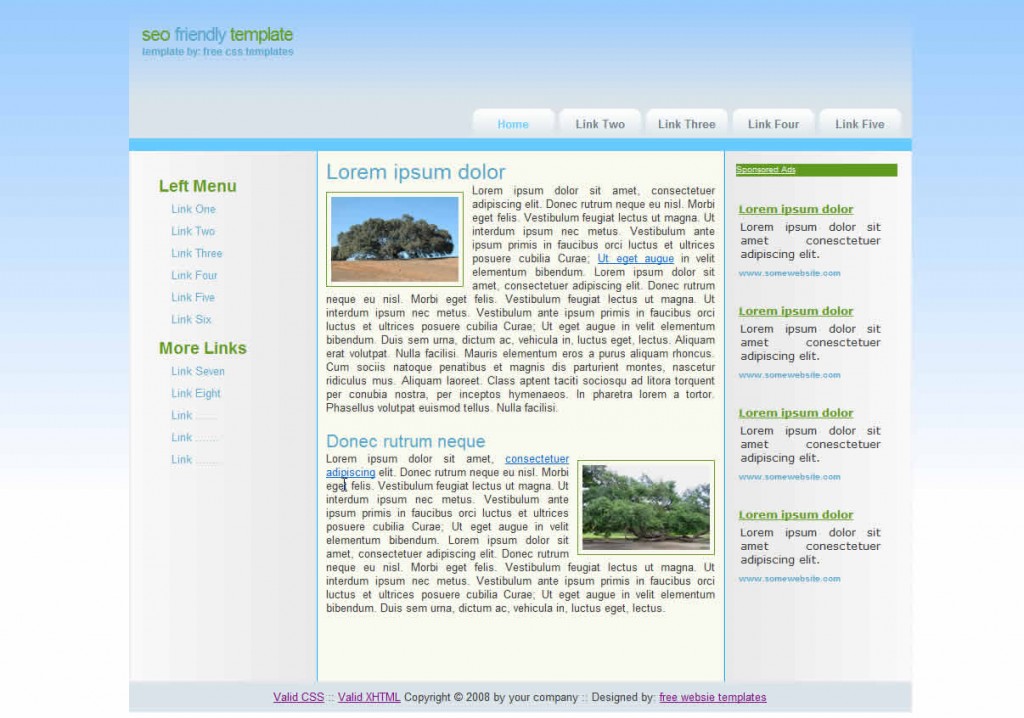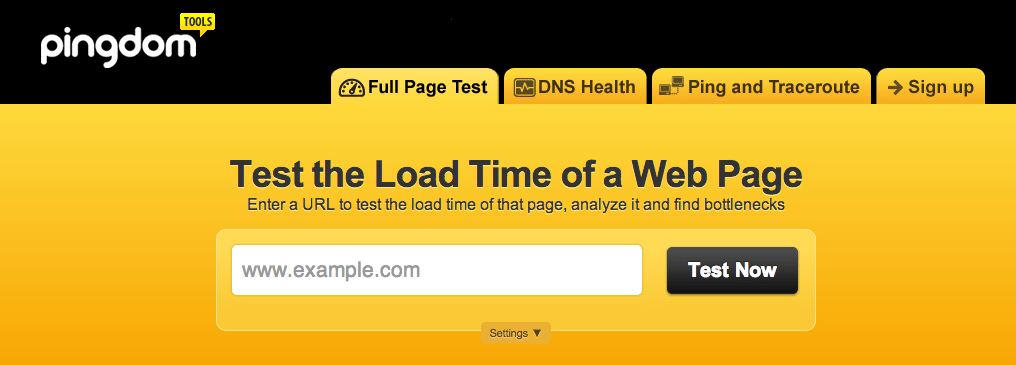A new trend in law firm web design is delivering “SEO Ready” or “SEO Friendly” websites that should be serving as a solid base for future efforts for SEO for a law firm. Generally this is an added bonus of the web designer, but in some cases extra fees are charged for this type of set up.
So what exactly goes into “SEO Friendly” web design? Here’s a big hint: it should be a lot more than just filling out your title tags for you!
While I could easily stretch this article to 4000 words and still not cover all the minutiae of SEO friendly design, I’m going to stick to a few basics that should give new site owners a quick checklist to run through to see whether or not their site is up to snuff.

Well doesn’t this SEO friendly site look…professional…
Preliminary Keyword Research
This, I think, is one of the bigger warning signs indicating that you might have been duped. How is your web designer supposed to know what your business should be chasing if you’ve never even discussed the direction you want to take?
While it’s easy enough to pick a few obvious keywords for your site to focus on, it takes a lot of work (and a lot of interaction) to figure out the best direction for a client’s keyword list.
At a minimum, we try and determine a few key traits about a customer’s client base in order to figure out what their most lucrative keyword segment is, as well as determine what kind of business the client wants. This is information that can’t be gleaned from an old website or content the client might provide. For example, we had client, a home improvement company, that when they came on was ranking fairly well for (and getting business from) doing wallpaper and painting work. Seems like a no brainer to chase those keywords right?
Wrong! Our client was sick of wallpapering and painting work and the amount of tire kickers that he had to send bids to was eating up a lot of his time. He had no idea that all this business he didn’t want was coming from the fact that he was so well-optimized for those phrases. After a short discussion we determined the direction he wanted to go in and created our design and SEO campaign to follow suit. He’s now taking on more of the higher-paying work that he wants.
This is the type of research that should be driving on-page SEO decisions when it comes to your web design. We typically use some of the following questions to feel out what kind of business our clients are looking for and incorporate the answers into our preliminary research:
- What would be “the perfect” lead for your business?
- Currently, what kind of new business are you bringing in. Is this what you want to focus on?
- What geographic locations do you currently work in? Do you provide on-site services or serve customers from a business location?
- Could you provide a range of towns/areas you would want to provide services for?
- Who would you consider some of your main competitors?
- Is there any type of work in your field you would want to avoid?
Decent Load Times
Site speed is an increasing factor in search rankings, and taking the time to code out a website that loads quickly should be a top priority. Now a reasonable load time depends entirely on what kind of site you’re running – but generally, anywhere under 1.5 seconds would be considered good in my book – though don’t fret if you see that number change each time you run a speed check.

Pingdom’s site speed check. Check it out here.
During your development process I’d recommend keeping tabs on how long it’s taking your site to load. You can run this tool on a development server that your web designer might have supplied to give you an idea of how it’s looking so far – but the real test is once that set is live and hosted on your servers.
There’s a few quick things you can do speed up your site without too much of an investment – I’ve actually covered the topic before on a guest post I wrote for Link Assistant about a month ago so I’ll try and cover some fresh ideas. For that my previous post, head over to LinkAssistant.com.
Complete Title/Meta Tags
Yeah, I riffed on these earlier in the article, but this remains an important step. You’ll want to be on the lookout for a few things here:
- Unique title tags, meta tags, and meta descriptions for each page
- Making sure the tags used are relevant to the content on the page
- Make sure they remain under the recommended length for each tag
- Title Tags: 60 characters
- Meta Tags: 160 characters
A quick tool you can use to check these quickly is Screaming Frog or Xenu. These programs will allow you to “spider” your website and can quickly give you a look at all of the title and meta tags in use without having to page through each site and check these manually. There are free versions of each of these programs so you won’t need to dish out any cash.
Outbound Do Follow Links per Page
Having too many outbound links per page is also a warning sign this site isn’t as SEO friendly as you might have thought.
While it’s time consuming and monotonous to manually check these – I’d again fall back on Screaming Frog and Xenu to check through your site. Screaming Frog in particular will give you a “outbound links per page” metric you can use to see whether you should be concerned.
Generally it takes a good amount of outbound links per page to consider them a problem – I’d recommend getting concerned if you see anymore than 70 outbound links per page – especially if it is the same amount of outbound links appear on all pages. Steps to get this resolved include no-following internal links, reducing the amount of navigation present on the site, and reducing footerwide links you have on each site.
WC3 Code Validation

The WC3 Markup Validator remains the defacto source for checking to make sure your website was coded up to current web standards. Having a properly coded site is vital these days, and if you’re seeing too many errors showing up through this tool it may be good to bring it to the attention of your web designer and have him or her fix these errors.
There will be a lot of erroneous warnings that come up depending on how the site is coded and what CMS it’s running, but this is a quick way to see just how friendly your site is.
Google Search Console: 404 Errors, Sitemaps & HTML Improvements
 In addition to using WC3 Validation, Google Search Console remains an important source for determining just how SEO friendly your site is.
In addition to using WC3 Validation, Google Search Console remains an important source for determining just how SEO friendly your site is.
There’s going to be a few item’s you’ll want to check out here – this tool contains a lot of information to determine whether or not your site is ready for an SEO campaign. If you don’t have both Analytics and Google Search Console set up – that’s a pretty big warning sign. If you do – proceed to the next steps.
Health>Crawler Errors
This section will contains any 404ed links that Google is running into as it crawls your website. Any good web designer (capable of coding out SEO friendly sites) should be taking the time to 301 redirect any old URL structure over to your new architecture. This is one of the repeat offenders I see in any SEO friendly website our company inherits.
You’re not only losing backlinks to those old pages when these aren’t set up – you’re also losing customers; as they’ll continue to trickle in through your broken URLs and quickly exit your site. Ideally, you want to see this error rate as low as possible (preferably zero) but maintaining this crawler health is an ongoing process.
Health>Blocked URLs
This screen helps us determine whether your robots.txt is set up correctly. While your designer may be blocking a few URLs (which is normal) Google will give you a red flag on this screen if their crawler or an excessive amount of URLs are blocked.
Optimization>Sitemaps
Sitemaps are another crucial part of a SEO friendly website – they allow Google to much more easily crawl through all your pages without getting stuck in your navigation. You should see a sitemap linked to your Webmaster tools profile (along with it’s current crawl data) and preferably a link to your sitemap in the footer of your site as well.
Optimization>HTML Improvements
This section shouldn’t be reporting any problems, but if you have duplicate meta tags, title tags, or URLs you get a nice breakdown of any issues Google finds here. This section is another good one to watch – as your site expands you’ll inevitably need to check up on this section and make some updates, but for a brand new site you should be in the clear.

If you see this message above – you’re in good shape…
Did Your Site Pass the Tests?
If you notice some red flags when going through these steps, you probably shouldn’t immediately pick up the phone to rip your web designer a new one. There are a huge number of factors that come into play here and some reasons why you’d see some of these tests come up negatively despite having a well designed and SEO friendly website.
If you have some questions about your sites you’d like us to look into feel free to sound off in the comments and we’ll post some updates!





